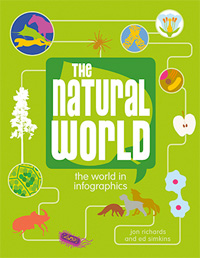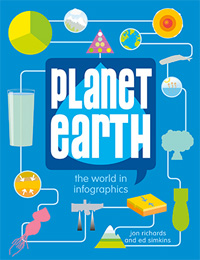| ________________
CM . . . . Volume XX Number 3 . . . . September 20, 2013
excerpt:
'A picture is worth a thousand words' has never been more clearly demonstrated than in the first two books in "The World in Infographics" series. In most fiction and nonfiction books, the pictures and illustrations are added to support the message of the written words. The opposite is the case in "The World in Infographics" series. The icons, graphics, and pictograms are the primary vehicle for transmitting information. The text is the supporting material. The excerpt above accompanies a visual representation of a white moth with the number 98% in large bold print, and a very small gray moth inside the larger moth with the number 2% in small print. Beside this, there is a large gray moth with the number 95% in large bold print, and a much smaller white moth inside the larger moth with the number 5% in small print. The visuals, so much better than any words, enable the reader to understand and absorb the information quickly. Infographics are designed to make readers remember. Young readers, still learning the skill of interpreting printed text, will be aided in visualizing the information by the clear and colourful visual "infographics". Equally, young readers still learning the skill of interpreting information graphically will be aided by the limited but supportive text accompanying the illustrations. Kudos to author Jon Richards and illustrator Ed Simkins on a very successful collaboration. Each book begins with a colourful table of contents which combines topics and page numbers in circles with some related illustrations. The books also include an excellent glossary. The index is present in alphabetical order, but the font size varies as in a tag cloud to represent which words are found most frequently on the pages indicated. Also included is a list of resources for more information. One of the listed resources in both books is www.dailyinfographic.com, "a comprehensive collection of infographics on an enormous range of topics that is updated every single day!" Although there are no citations for the facts presented in the books, several sources of information are credited at the bottom of the glossary pages. The Natural World: The World in Infographics covers topics ranging from microorganisms to "a giant fungus of the honey mushroom species [which] covers 3.4 mi.2 (8.9 km2) of land in Oregon, USA, making it the largest known organism by area". Measurements are given in both imperial and metric form throughout the book. Readers learn which animals are record breakers in size, speed, strength, jumping ability, longevity and many more attributes. "Genes and Cell Division" illustrates a DNA molecule, cell division, chromosomes, and genes, accompanied by interesting facts, such as, "There are an estimated 3 billion DNA bases in the human genome." Planet Earth: The World in Infographics covers topics about the geology and geography of our planet. Some of the topics discussed are rock formation, volcanoes, oceans, air, and the water cycle. The chapter "Restless Earth" shows the locations where most major earthquakes occur, and the strength and location of some of the strongest earthquakes ever measured. Hint: maybe it's time to buy a nice 'stable' retirement home in Antarctica. Be prepared to hear a number of 'Did you know that...' questions from young readers eager to share all kinds of interesting information that they discover in these books. Whether teachers are using them to teach how to interpret and visualize facts and statistics from graphs, pictograms, and illustrations, or whether students are engaging with the information on their own, these books are sure to be popular learning tools. More proof that learning complex concepts doesn't have to be tedious or boring if the information is presented in the right format. Well done Owlkids Books. Highly Recommended. Suzanne Pierson is a retired teacher-librarian, currently instructing librarianship courses at Queen's University in Kingston, ON.
To comment
on this title or this review, send mail to cm@umanitoba.ca.
Copyright © the Manitoba Library Association. Reproduction for personal
use is permitted only if this copyright notice is maintained. Any
other reproduction is prohibited without permission.
NEXT REVIEW |
TABLE OF CONTENTS FOR THIS ISSUE
- September 20, 2013.
AUTHORS |
TITLES |
MEDIA REVIEWS |
PROFILES |
BACK ISSUES |
SEARCH |
CMARCHIVE |
HOME |

